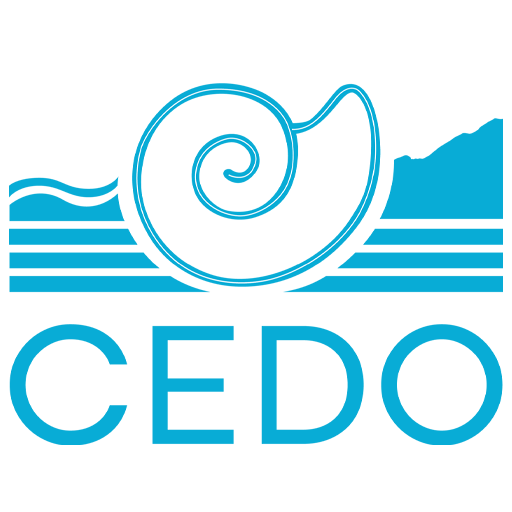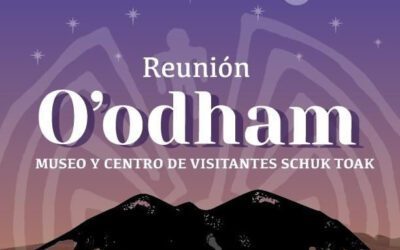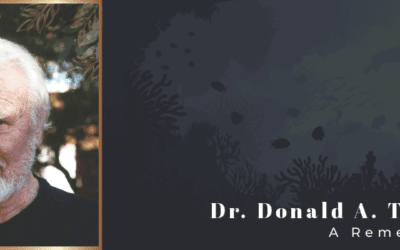[vc_row][vc_column][vc_separator][vc_column_text]By: Abelardo Castillo Rosas, Associate Specialist in Human Geography and Wildlife, CEDO | Cover photo: Heather and Andrew Hodgson[/vc_column_text][/vc_column][/vc_row][vc_row][vc_column width=”1/2″][vc_single_image image=”2038″ img_size=”full” add_caption=”yes” onclick=”link_image”][/vc_column][vc_column width=”1/2″][vc_column_text]On September 17 at noon, at the Puerto Peñasco dock, a group of people found a stranded Kogia sima dwarf sperm whale. It was still alive but in very bad condition. People tried to tend to it and they moved it enough so that the whale was able to go back into the water. However, they didn’t report the stranding to the corresponding authorities.
Later, Humberto González Veliz, the biologist in charge of wildlife monitoring and protection at ZOFEMAT in Puerto Peñasco, took the task of tracking the dwarf sperm whale and survey the area in case it got stranded again. Sadly, the situation repeated itself that same afternoon at El Mirador beach where the whale was found dead a few hours later. CEDO was advised from the beginning of the monitoring efforts to keep an eye for a very possible new stranding given the poor condition of the cetacean. When the dead animal was found, it was immediately dealt with and the Federal Attorney for Environmental Protection (PROFEPA) was notified.
The dead whale was transferred to the CEDO facilities where samples were taken and the body was buried not before making sure that the cause of death was not due to unnatural causes such as plastics ingestion or trauma caused by human activities. We found no evidence of this and are still waiting for the samples’ results to give a cause of death as accurate as possible.[/vc_column_text][/vc_column][/vc_row][vc_row][vc_column width=”1/2″][vc_column_text]The specimen was an adult female measuring 2.8 meters (9.1 ft) in length. The skull was fleshed out and we’re working on preserving it, along with the rest of the skeleton which we hope to recover in the next few months, to exhibit it and learn more about this rare animal. This will encourage conservation and a better understanding of the importance of protecting our oceans as the presence of this and other cetaceans in the region are a good indicator of the health of marine ecosystems.[/vc_column_text][/vc_column][vc_column width=”1/2″][vc_single_image image=”2042″ img_size=”full” add_caption=”yes” onclick=”link_image”][/vc_column][/vc_row][vc_row][vc_column][vc_column_text]It’s also important to mention that although dwarf sperm whales are distributed in temperate and tropical waters around the world, very little information is available on the seasonal distribution or movements of this species, which reaches a standard length of 2.7m (8.8 ft) and an average weight of 272 kg (600 lbs).[/vc_column_text][/vc_column][/vc_row][vc_row][vc_column width=”1/2″][vc_single_image image=”2040″ img_size=”full” onclick=”link_image”][/vc_column][vc_column width=”1/2″][vc_column_text]This species lives on or near the limit of the continental shelf. Young and immature individuals live near the coast, while adults are found in deeper waters. In addition, in Mexico the species has been protected since Mexico began participating in international agreements (NOM-059-SEMARNAT-2010) and when it agreed to the Convention on International Trade in Endangered Species of Wild Fauna and Flora (CITES) in 1991, CITES Appendix II, subject to special conservation.
[/vc_column_text][/vc_column][/vc_row][vc_row][vc_column width=”1/2″ overflow=”default” css=”.vc_custom_1630596729458{margin-top: -40px !important;border-top-width: -20px !important;}”][vc_column_text]Apparently, these cetaceans are not very affected by human activity. The occasions in which specimens have been caught in commercial fisheries have been very few
It should be noted, however, that this year there have been two beachings of this species on the coasts of Sonora. The first one was reported in January in Bahía San Jorge and this one in Puerto Peñasco. Two other beachings were reported in Puerto Peñasco and were tended to by CEDO staff—two Fin Whales (Balaenoptera physalus), a male and a female, measuring 10 m (30 ft) and 12.5 meters (40 ft) respectively, found in July, and a male Minke whale (Balaenoptera acutorostrata) found in August.
Although beachings and mortality in all species of cetaceans is normal, CEDO is paying attention and is concerned that there may be conditions that might be increasing these beachings, including climate change or altered environmental conditions, in addition to the serious issue of ocean plastic pollution.[/vc_column_text][/vc_column][vc_column width=”1/2″][vc_single_image image=”2044″ img_size=”full” add_caption=”yes” onclick=”link_image”][/vc_column][/vc_row][vc_row][vc_column][vc_column_text]References
- Una comunidad para naturalistas · NaturaLista © CONABIO, algunos derechos reservados.
- Urbán R., J. y M. Guerrero-Ruiz 2008. Ficha técnica de Kogia sima. Fichas de Especies del proyecto CK009 Conocimiento biológico de las especies de mamíferos marinos, incluidas en la Norma Oficial Mexicana-059-SEMARNAT-2001, Universidad Autónoma de Baja California Sur. Bases de datos SNIB-CONABIO. Proyecto No.CK009. México, D.F.
- http://www.conabio.gob.mx/conocimiento/ise/fichas/doctos/introduccion.html, Microsoft Word – Kogiasima00.rtf (conabio.gob.mx).
[/vc_column_text][/vc_column][/vc_row][vc_row][vc_column][vc_separator style=”shadow” border_width=”2″][vcj_team_member image=”1966″ name=”About the Author:” layout=”style3″ image_ratio=”portrait” color_name=”#ca972e”]Abelardo Castillo, Associate Specialist in Human Geography and Wildlife, CEDO.
Abelardo Castillo has been working on sustainable development issues since 1990, performing various conservation activities, environmental education and socio-environmental activism. He was certified as an environmental educator and in 2015 received training as a “Solar Ambassador” in Switzerland through the World Organization of the Scout Movement, Solafrica, and Greenpeace, and has been supported by the latter two in promoting the use of solar energy and its focus on community and people development to improve their quality of life and support ecosystem conservation. He currently works with CEDO’s Community Wellbeing team.
[/vcj_team_member][/vc_column][/vc_row][vc_row][vc_column][vc_column_text][ctct form=”1153″ show_title=”false”][/vc_column_text][/vc_column][/vc_row]









0 Comments